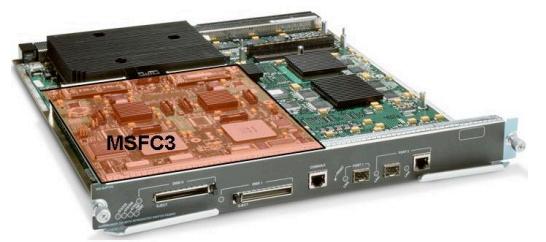“Why do we use MSFC Card? What are its benefits?” Many people usually put the question like this. What is the exact MSFC card and what is it used for? Here some discussion and experience from MSFC card users would give you some tips…
MSFC is short for the Multilayer Switch Feature Card.
In chassis based switches you have physical modules that handle various tasks:
- Line cards—physical connections such as 1Gbps SFP
- Service modules—specialized functions such as firewall, IPS/IDS, load balancers, etc
- Supervisors—“brains” of the switch which handle the logic and make forwarding decisions (this is a generalization).
Multilayer Switch Feature Card is the Layer 3 switching engine that sites on the Catalyst Supervisor as a daughter card. The MSFC is an integral part of the Supervisor Engine, providing high performance, multilayer switching and routing intelligence. On the MSFC daughter card, the route processor (RP) is located on the MSFC itself. Equipped with a high performance processor, the MSFC runs layer 2 protocols on one CPU and layer 3 protocols on the second CPU. These include routing protocol support, layer 2 protocols (Spanning Tree Protocol and VLAN Trunking Protocol for example), and security services.
In general, the MSFC is a special component on the supervisor that makes basic layer-2/3 forwarding decisions (this is a big generalization). In older switches, the MSFC function was actually handled on a dedicated module. In new supervisors, the MSFC is integrated into the supervisor.
Depending on the hardware some, logic/functions may be implemented in different hardware (e.g. the “this is a generalization” notes above). For example, in a Cisco 6500, you can get line cards with DFCs (distributed feature cards==more brains), which will allow some forwarding decisions to be made on the line-card rather than forwarding the traffic to the supervisor/msfc/etc.
The control plane functions in the Cisco Catalyst 6500 are processed by the MSFC and include handling Layer 3 routing protocols, maintaining the routing table, some access control, flow initiation, and other services not found in hardware. Performance of the control plane is dependent on the type and number of processes running on the MSFC. The MSFC3 can support forwarding rates up to 500Kpps. The MSFC provide a means to perform Multilayer Switching (MLS) and interVLAN routing.
The MSFC builds the Cisco Express Forwarding information Base (FIB) table in software and then downloads this table to the hardware Application-specific-integrated circuits (ASICs) on the PFC and DFC (if present) that make the forwarding decisions for IP unicast and multicast traffic.

Role of MSFC
1. Provide IOS based multi-protocol routing using a variety of routing protocols.
2. Work with the PFC for implementing layer 3 switching & traditional router based input/output ACL’s. Note, PFC can implement ACL’s without requiring a MSFC.
3. Provide other SW based features (like NAT, Policy Routing, Encryption etc) which are not supported in PFC hardware.
MSFC/Supervisor Compatibility Chart
| MSFC Model | Supervisor Model |
| MSFC1 | Supervisor 1 or Supervisor 1A |
| MSFC2 | Supervisor 1A or Supervisor 2 |
| MSFC3 | Supervisor 720 Models |
| MSFC4 | Supervisor 720-10GE Models |
Rs from https://learningnetwork.cisco.com/thread/24503 & https://supportforums.cisco.com/document/85621/understanding-msfc-pfc-and-dfc-roles-catalyst-6500-series-switch
More Topics Related to Cisco Modules and Cards
MSFC, PFC and DFC Roles in Catalyst 6500 Series Switch
Cisco Catalyst 6500 Series 8-Port 10 Gigabit Ethernet Module
Cisco 10GbE Optics Modules & Optical Standards
Cisco 10GBASE SFP+ Modules Overview
